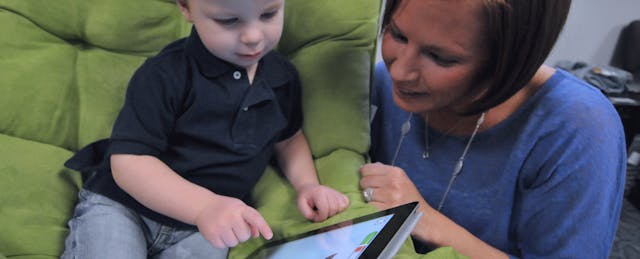The holidays can be the perfect storm of technology overload for kids: mile-long airport lines, days at a grandparent’s house without the regular toys, the disappearance of the school routines. It’s easy to let kids retreat into a corner with an iPad or cell phone, and see them come out an hour later, bleary-eyed and irritable.
With the influx of digital devices comes a whole new set of questions we--both parents and teachers of young children--have to answer. How much is too much time with the iPad or cell phone? How much structure should we put around children’s watching or playing of downloaded games?
As a specialist in early childhood education and development, and a mom of a three-year-old daughter, I see these questions as opportunities to chart a path through the thorny weeds of kids and technology use. The extra time of the holidays gives us a chance to ask what kids are getting out of their device use, and how we can help them best manage and be mindful about their time.
Any hard and fast rule about technology, or much of anything else, is bound to give way during the holidays. There are times, like during a long delay at the airport, when I know I’m less aware of my daughter’s technology use than I should be, and let her watch a few pre-loaded videos on the iPad. But later, when it’s just the two of us, I ask myself whether my husband and I couldn’t be more thoughtful about what our daughter sees and plays with and why.
As a scientific advisor for a company creating online interactive “brain games” to support children’s executive function (abilities to plan, shift attention, and focus), I’m interested in how we can teach skills in a way that’s engaging and feels like play--and that sets children up for future academic learning.
From my own professional experiences and my personal experience as a mother, I know that a constructive digital strategy is critical for both parent and child. Below are a few guidelines to keep in mind for device use this holiday season:
- The age of the child matters: A young child’s attention span develops over time, and what may be a learning experience for a six-year-old may be way too long for a three-year-old. Limit the use of electronic devices to spurts of ten to fifteen minutes for four- and five-year-olds, and add time in increments based on age.
- Children benefit from talking about what they see: Research suggests that children learn more from technology when they have a discussion about what they see with an adult. You can ask who the main characters were, how the game went, and how the game might relate to their “real lives.”
- Children benefit from interacting with technology: Although it’s possible to use the iPad simply to watch videos, it’s important to think of building children’s knowledge and skills through active interaction with devices, rather than passive viewing. A number of games are popping up that use well thought-out play to engage children, letting them select options and make choices rather than lean back and watch.
- Children need clear guidelines about when to put the devices down: It’s important to help children realize that the holidays are primarily about people and celebrations, rather than screens. Children may need subtle or not-so-subtle reminders to put their devices down and engage with the world around them.
We don’t have to think of children and device use as a negative equation. With some control over what and how they use educational technology, children can learn and develop skills, and arrive back at school even more prepared to learn, attend and thrive.


